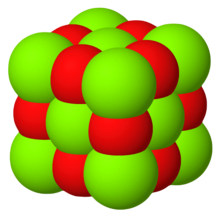 | |
 | |
| Names | |
|---|---|
| IUPAC name Strontium oxide | |
| Other names Strontia | |
| Identifiers | |
| CAS Number | |
| 3D model (JSmol) | |
| ECHA InfoCard | 100.013.837 |
| EC Number |
|
| PubChem CID | |
| UNII | |
| CompTox Dashboard (EPA) | |
InChI
| |
SMILES
| |
| Properties | |
| Chemical formula | SrO |
| Molar mass | 103.619 g/mol |
| Appearance | colorless cubic crystals |
| Density | 4.70 g/cm |
| Melting point | 2,531 °C (4,588 °F; 2,804 K) |
| Boiling point | 3,200 °C (5,790 °F; 3,470 K) (decomposes) |
| Solubility in water | reacts, forms Sr(OH)2 |
| Solubility | miscible with potassium hydroxide slightly soluble in alcohol insoluble in acetone and ether |
| Magnetic susceptibility (χ) | −35.0·10 cm/mol |
| Refractive index (nD) | 1.810 |
| Structure | |
| Crystal structure | Halite (cubic), cF8 |
| Space group | Fm3m, No. 225 |
| Coordination geometry | Octahedral (Sr); octahedral (O) |
| Thermochemistry | |
| Heat capacity (C) | 44.3 J·mol·K |
| Std molar entropy (S298) |
57.2 J·mol·K |
| Std enthalpy of formation (ΔfH298) |
-592.0 kJ·mol |
| Hazards | |
| Flash point | Non-flammable |
| Related compounds | |
| Other anions | Strontium sulfide |
| Other cations | Beryllium oxide Magnesium oxide Calcium oxide Barium oxide |
| Related compounds | Strontium hydroxide |
| Except where otherwise noted, data are given for materials in their standard state (at 25 °C , 100 kPa).
| |
Strontium oxide or strontia, SrO, is formed when strontium reacts with oxygen. Burning strontium in air results in a mixture of strontium oxide and strontium nitride. It also forms from the decomposition of strontium carbonate SrCO3. It is a strongly basic oxide.
Uses
About 8% by weight of cathode-ray tubes is strontium oxide, which has been the major use of strontium since 1970. Color televisions and other devices containing color cathode-ray tubes sold in the United States are required by law to use strontium in the faceplate to block X-ray emission (these X-ray emitting TVs are no longer in production). Lead(II) oxide can be used in the neck and funnel, but causes discoloration when used in the faceplate.
Reactions
Elemental strontium is formed when strontium oxide is heated with aluminium in a vacuum.
References
- ^ Lide, David R. (1998). Handbook of Chemistry and Physics (87 ed.). Boca Raton, Florida: CRC Press. pp. 4–87. ISBN 0-8493-0594-2.
- Pradyot Patnaik. Handbook of Inorganic Chemicals. McGraw-Hill, 2002, ISBN 0-07-049439-8
- Ober, Joyce A.; Polyak, Désirée E. "Mineral Yearbook 2007:Strontium" (PDF). United States Geological Survey. Retrieved 2009-09-14.
- Minerals Yearbook. Bureau of Mines. May 8, 2011. ISBN 9781411332270 – via Google Books.
- Méar, F; Yot, P; Cambon, M; Ribes, M (2006). "The characterization of waste cathode-ray tube glass". Waste Management. 26 (12): 1468–76. Bibcode:2006WaMan..26.1468M. doi:10.1016/j.wasman.2005.11.017. ISSN 0956-053X. PMID 16427267.
External links
| Strontium compounds | |
|---|---|